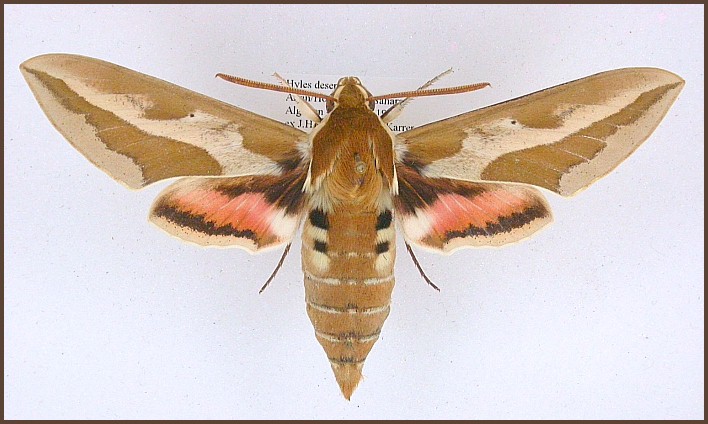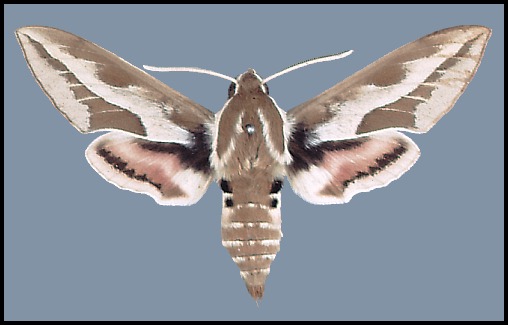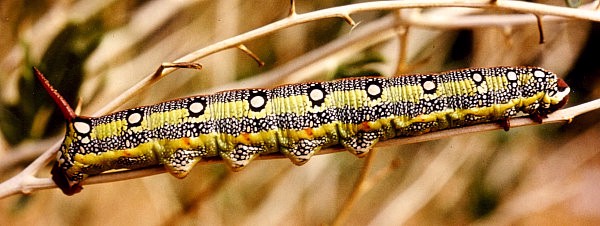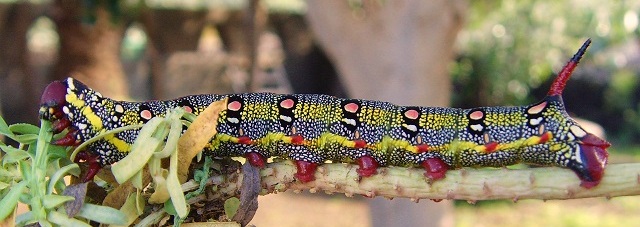UK: Barbary Spurge Hawkmoth, F: Sphinx du Tithymale
Deilephila mauretanica deserticola Staudinger, 1901, in Staudinger & Rebel, Cat. Lepid. palaearct. Faunengeb. 3: 102.Type locality: Biskra, Algeria (Neotype designated by Eitschberger (in Danner, Eitschberger & Surholt, 1998)).
(Taxonomic note. The taxon deserticola was first established as an aberration of Deilephila mauretanica by Bartel, therefore this name is unavailable. It was first raised to subspecific level by Staudinger and is therefore attributable to him.)
[Further details on this species, as well as photos of all stages, can be found on AfroMoths.]
Holarctic; western Palaearctic region. Pleistocene refuge: Monocentric -- Afroeremic refuge as part of a mauretanica/deserticola complex. Part of the present-day Saharo-Arabian faunal element.


Wingspan: 45--75mm. Variable, especially in colour intensity and size; the smallest examples come from the driest areas and are usually referred to as f. saharae Günther, 1939, which are just small, pale replicas of larger individuals. In the southern Atlas Mountains, this subspecies merges with Hyles tithymali mauretanica (Staudinger, 1871).
Occurs in desert steppe, in stabilized sand-dunes, in dry, sandy river-beds and, especially in southern Algeria, the fringes of oases.
Active by day during the hottest times of the year. Pairing takes place between 01.30 and 03.00 hours (Harbich, 1994), a feature which separates the Hyles tithymali species group from Hyles euphorbiae (Linnaeus, 1758).
Continuous-brooded; throughout the year but commonest in spring. All stages of development can be present at the same time between April and early September (de Freina, 1994). Mass emergences may take place after multiple periods of heavy winter rain.
OVUM: Cannot be distinguished from subsp. tithymali (Boisduval, 1834).
LARVA: Cannot be distinguished from subsp. tithymali.


Occurs throughout the year but most commonly during April and May. Very tolerant of temperatures in excess of 36° C (de Freina, 1994).
Major Hostplants. Euphorbia guyoniana (Speidel, Hassler, Back & Hassler, 1989; de Freina, 1994).
Minor Hostplants. Euphorbia calyptrata, Euphorbia rigida and Euphorbia terracina (Rungs, 1945; Rungs, 1981).
PUPA: As Hyles euphorbiae. Most, but not all, overwinter. Usually killed by sub-zero temperatures. May diapause for several seasons until triggered to emerge by heavy rainfall.
None recorded.
North Africa south of the Atlas Mountains, from the Western Sahara (Rungs, 1992), eastern Mauritania (Rungs, 1945; Rungs, 1981), Morocco and southern Algeria (Speidel, Hassler, Back & Hassler, 1989; Eitschberger, Mooser & Müller, 2014) to western and northern Egypt (Lewandowski & Lewandowski-Krenz, 2014) and northwestern Saudi Arabia (Paulo Alves, iNaturalist 2024). During the last ice age this subspecies probably also occurred as far east as Yemen, where it has since given rise to a distinct and isolated subspecies -- Hyles tithymali himyarensis Meerman, 1988. This view is also supported by Meerman (1993).
Reported from the island of Fuerteventura, Canary Islands, by Gil-T. (2002) and Eitschberger & Saldaitis (2006). However, the illustration given by the latter is of a pale, desertic ecotype of Hyles tithymali tithymali, a condition probably caused by feeding on Euphorbia paralias growing on hot, dry sand dunes (Hundsdörfer, Kitching & Wink, 2005a). Additionally, a molecular phylogenetic study of the population places it firmly within Hyles tithymali tithymali (Hundsdörfer, Kitching & Wink, 2005a). Although it may be possible for individuals of Hyles tithymali deserticola to occasionally cross the 100km of water between Morocco and Fuerteventura, there is (as yet) no genetic evidence for this.
In 2007, three individuals were captured on Malta during a strong migration of other species from the south (Catania, 2008).
Extra-limital range. Senegal.
 Return to species list
Return to species list